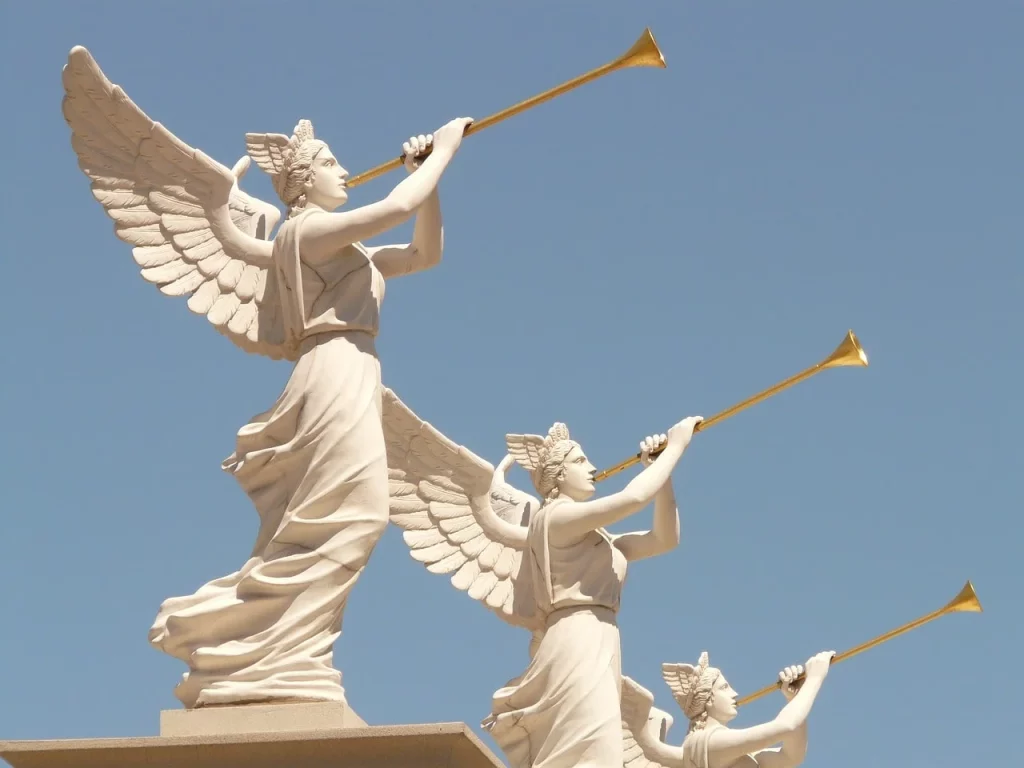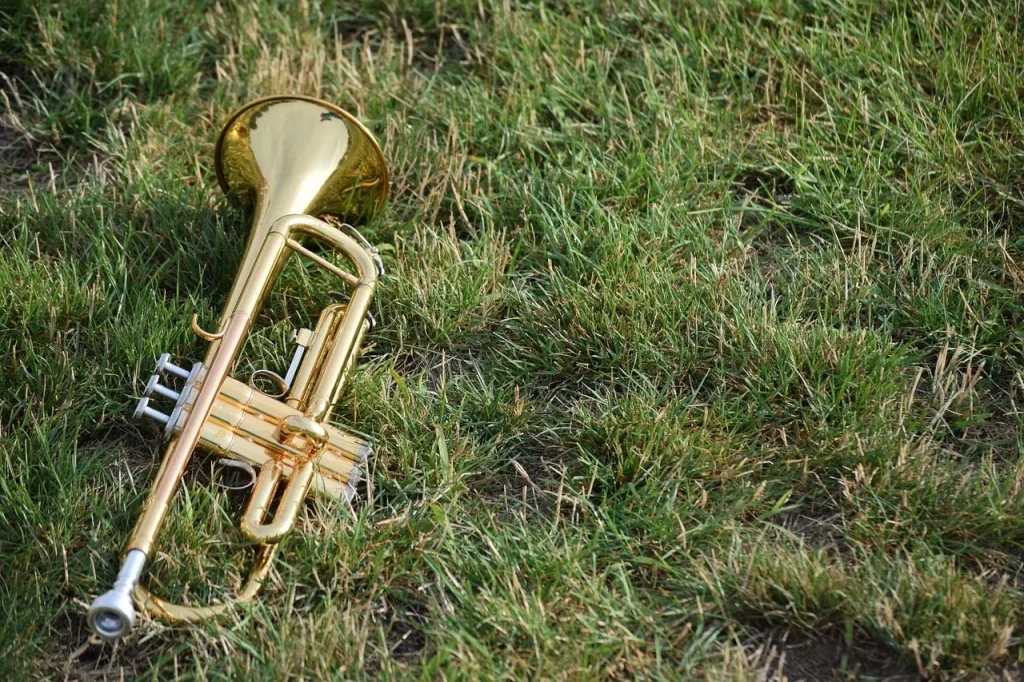Welcome to the vibrant world of the trumpet, an instrument that has danced through the pages of history with a flair that’s hard to ignore. As we uncover some remarkable facts about this brilliant brass instrument, you’ll be surprised to learn how deeply it’s intertwined with culture, history, and art.
From its humble beginnings to its status as a symbol of power and elegance, the trumpet’s journey is as colorful as the music it produces. Prepare to be enthralled by the tales and trivia of this beloved musical companion.
What a beautiful instrument, capable of both power and subtlety.
Wynton Marsalis
Trumpet Facts
Let’s step into the realm of trumpet facts, where every detail counts. Read carefully, because I created a quiz at the end of this page to see if you’ve truly are a trumpet expert.
- Evidence of the trumpet dates back to 1500 BC, with discoveries in King Tutankhamun’s tomb in Egypt.
- This brass instrument is known for its high pitch, the highest in its family.
- The sound of the trumpet is created when a player vibrates their lips against the mouthpiece.
- Typically, modern trumpets are equipped with three valves, aiding in pitch alteration.
- Originally, trumpets were used in battle or hunting as signal instruments, not for music.
- The trumpet’s role as a solo instrument was significantly developed in jazz music.
- Louis Armstrong, a famous trumpeter, is credited with making the trumpet a prominent jazz instrument.
- Known for its high pitch, the piccolo trumpet is the smallest member of the trumpet family.
- Before valves were invented, trumpets were simple straight tubes.
- In classical compositions, the trumpet often represents majestic and victorious themes.
- When stretched out, a trumpet’s tubing is about 6.5 feet (2 meters) in length.
- Miles Davis, a legendary trumpeter, is celebrated for his creative jazz contributions.
- The flugelhorn resembles a trumpet but produces a more soothing tone.

- Trumpets are commonly made from brass but can also be silver or gold-plated.
- A mute can be inserted into the trumpet’s bell to modify its sound.
- Famous baroque music for the trumpet was composed by Bach and Handel, showcasing its diversity.
- German and Austrian orchestras often prefer the rotary valve trumpet.
- Plunger muting in jazz trumpeting creates a unique sound effect.
- An octave lower than the standard B♭ trumpet is the bass trumpet.
- Chet Baker was renowned for his lyrical style of trumpet playing.
- The herald trumpet, with its extended bell, is often used in ceremonial contexts.
- Wynton Marsalis is acclaimed for his expertise in both jazz and classical trumpet.
- From classical to rock, trumpets are utilized across various music genres.
- A trumpet without valves is known as a bugle, limited to a few notes.
- The pocket trumpet is a compact variation of the standard trumpet.
- Famous for his unique trumpet with a bent bell, Dizzy Gillespie stood out in jazz history.
- Trumpeters can alter pitch by changing their embouchure, or lip configuration.
- Close relatives to the trumpet include the cornet and flugelhorn.

- Orchestral trumpet parts are often technically demanding, requiring skilled players.
- During medieval times, trumpets were commonly used for official announcements and ceremonies.
- The highest recorded note on a trumpet is a C8.
- Bria Skonberg is known for fusing traditional jazz with contemporary styles on the trumpet.
- The Harmon mute creates a distinctive ‘wah-wah’ sound in the trumpet.
- Ancient civilizations like Greece and Scandinavia also had trumpet-like instruments.
- Arturo Sandoval, a Cuban-American trumpeter, is renowned for his exceptional skill.
- The range of a trumpet covers roughly three octaves.
- Trumpet ensembles are frequently featured in fanfare and ceremonial music.
- Natural trumpets, used in the Baroque era, had no valves.

- Most modern trumpets use a piston valve mechanism.
- Some modern composers have explored avant-garde compositions for the trumpet.
- Alison Balsom, a British trumpeter, has popularized classical trumpet in the contemporary scene.
- Historically, trumpets have played a vital communication role in military settings.
- The material of the mute, such as metal or rubber, influences the trumpet’s sound.
- In the ancient Greek Olympics, trumpets were used to announce the winners.
- Clark Terry was famous for his “mumbling” jazz trumpet technique.
- In brass and marching bands, the trumpet often takes a leading role.
- Trumpeters sometimes use extended techniques like multiphonics in contemporary music.
- Trumpet concertos form an important part of the instrument’s classical repertoire.
- Used in ceremonial music, fanfare trumpets are characterized by their long, straight design.
- The role of the trumpet in orchestral music expanded notably in the 19th century.
Trumpet Myths

After our deep dive into the world of trumpets, it’s time to explore the myths. Let’s find out the actual truth behind some common myths.
- Trumpets Are Only for Loud, Bold Music
While trumpets are often associated with powerful, brassy sounds, they are incredibly versatile instruments. They are capable of producing a wide range of tones, from soft, mellow melodies in jazz and classical music to bright and spirited tunes in marching bands and orchestras. - Playing the Trumpet is Easy
Mastering the trumpet requires significant practice and skill. The player must develop a strong embouchure (the way the mouth is formed on the mouthpiece), precise breath control, and finger dexterity. It’s a challenging instrument, and proficiency is usually achieved over years of dedicated practice. - Trumpets Have Remained Unchanged for Centuries
Modern trumpets have evolved significantly from their historical counterparts. Innovations in design and materials have improved their range, tone, and playability. The addition of valves, for instance, has expanded their musical capabilities, allowing for more complex and varied compositions. - Trumpet Players Only Need to Learn Classical Music
Trumpet players often explore a variety of musical genres. Beyond classical music, they delve into jazz, pop, rock, and even electronic music. The trumpet’s adaptability makes it a sought-after instrument in diverse musical contexts, challenging players to continuously expand their repertoire. - The Louder the Trumpet, the Better
Volume is just one aspect of trumpet playing. Quality of sound, tone, musical expression, and technique are equally, if not more, important. A skilled trumpet player is recognized not just by how loud they can play but also by their control, musicality, and ability to convey emotions through their instrument.
No products found.
Trumpet Quotes

Our musical journey is going great so far. Let’s continue with some quotes. Let me know more in the comments so I can add them to the list.
To jazz, or not to jazz, there is no question!
Louis Armstrong
Louis Armstrong, an iconic jazz musician and trumpeter, humorously riffs on Shakespeare to emphasize his unwavering commitment to jazz music.
The trumpet does not play the notes, I play them.
Miles Davis
Miles Davis, a legendary jazz trumpeter, emphasizes the musician’s role in creating music, rather than the instrument itself.
Playing the trumpet is an art – one must feel it and love it.
Dizzy Gillespie
Dizzy Gillespie, a major figure in the development of bebop and modern jazz, highlights the emotional connection and passion required in playing the trumpet.
The trumpet is a demanding mistress, but the rewards are sweet.
Herbert L. Clarke
Herbert L. Clarke, a famous cornet player, composer, and conductor, metaphorically describes the challenges and joys of mastering the trumpet.
In the world of brass instruments, the trumpet is the king.
Arturo Sandoval
Arturo Sandoval, a Cuban-American jazz trumpeter, pianist, and composer, acknowledges the trumpet’s prominent status among brass instruments.
Trumpet FAQ

We move on to the FAQ section, but remember: this is your final step before the quiz. Read carefully to catch every note of wisdom!
- How does a trumpet work?
When you blow into the mouthpiece, your breath causes the air inside the trumpet’s tubing to vibrate. These vibrations travel through the tubes and are shaped by the valves you press down. What comes out is the rich, bright sound we associate with trumpets. - Why is the trumpet considered the best instrument?
The best is subjective, but trumpet enthusiasts have their reasons! The trumpet’s powerful sound can both blend into an orchestra and stand out as a solo voice. It’s versatile, used in genres from classical to jazz to pop. Plus, its compact size makes it portable. But really, for many, it’s the rich, soul-stirring sound that steals the show. - Are trumpet players good kissers?
This one’s more myth than fact, but it’s fun to think about! The idea is that since trumpet players use their lips and breath control a lot, they might be more skilled in… other lip-related activities. Scientifically? There’s no real proof. But hey, it makes for a charming ice-breaker at parties! - What’s the history behind the trumpet?
The trumpet has a storied past, dating back thousands of years. Ancient civilizations like the Egyptians and Greeks used primitive trumpets for religious and military purposes. Over the centuries, it evolved from a signaling device into a musical instrument. By the time of the Baroque era, it started resembling the modern trumpet, thanks to the addition of valves. - How do you take care of a trumpet?
Taking care of a trumpet is key to its longevity and sound quality. Regular cleaning is a must. You’ll need to oil the valves and slide grease for the slides to keep them moving smoothly. Always handle it with care; dents and damage can affect its sound. And when not in use, storing it in a case is the best way to keep it safe.
No products found.
Trumpet Trivia

Welcome to the trumpet quiz! Remember, if you don’t hit the right notes with your answers, you might find your next shower turning into a surprise brass concert!
Conclusion
The trumpet’s journey from ancient heraldry to modern jazz clubs encapsulates a legacy of transformation and enduring appeal. Its bright, piercing sound has not only heralded kings but has also given voice to the soulful expressions of jazz and the spirited marches of bands.
The trumpet’s versatility is a testament to human creativity and passion. It has become more than an instrument; it’s a symbol of artistic expression across cultures and eras.
As we part ways, let’s close this article with a funny question: If you were to compose a trumpet fanfare for any occasion, what would be its title and why? Let me know in the comments.
1 Source Used For This Article

